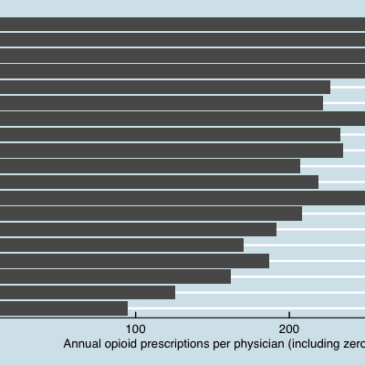The Centers for Disease Control suggest that every day, 91 Americans die from an opioid overdose.1 The development of opioid dependence and addiction is complex, and some have focused on the contributing role of prescription medications to what has been commonly been called the opioid epidemic. One supply-side policy aimed at curbing the crisis involves reducing the over-prescription of opioids. This week, STASH reviews a study by Janet Currie and Molly Schnell that looks at how opioid prescription relates to physician education.
What is the research question?
Is the quality of physician education related to opioid prescribing?
What did the researchers do?
The authors analyzed 2006 to 2014 prescription data from QuintilesIMS and US News and World Report medical school rankings to examine the correlation between the number of opioid prescriptions written yearly and the ranking of the medical school where physicians obtained their first medical degree. The authors also examined whether factors such as patient selection and physician selection might provide alternative explanations for an observed relationship between opioid prescribing and medical school ranking. In this study, medical specialty and practice location are proxies for patient selection because these factors are associated with opioid prescription practices, overall. Graduation cohort is the proxy for physician selection because the authors suggest that it is more difficult for more recent cohorts to be accepted into medical school.
What did they find?
The authors find that there is a striking relationship between the rank of a physician’s medical school and their opioid prescription behavior: on average, physicians who attend higher ranked medical schools prescribe fewer opioids (see Figure 1). The association between medical school ranking and opioid prescription persists even after taking various factors into consideration, including medical specialty, county of practice, and graduation cohort.

Figure. Annual opioid prescriptions per physician by Medical School Rank (adapted from Currie and Schnell, 2017). Click image to enlarge.
Why do these findings matter?
The findings suggest that stronger policies that require medical schools to improve their training in terms of prescriber practices – for example, incorporating Center for Disease Control’s opioid prescribing guidelines in their curriculum – might help reduce opioid prescriptions.
Every study has limitations. What about this one?
One of the limitations of the data used in the study is that it didn’t contain information about the number of patients seen by each physician. This data limits that authors’ ability to know for sure if physicians from lower ranked medical schools prescribe more opioids because they see more patients. Also, although the authors ruled out several confounding factors, a number of unmeasured factors might be responsible for the observed relationship.
For more information:
If you or a loved one are suffering from an opioid addiction, don’t hesitate to reach out for help. There are several Prevention, Treatment & Recovery Resources available.
If you are a health professional, there are resources available where you can learn about safe opioid prescribing.
— Pradeep Singh
What do you think? Please use the comment link below to provide feedback on this article.
________________
[1] The figure includes the number of prescription and non-prescription opioid overdose deaths.




